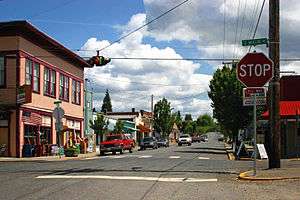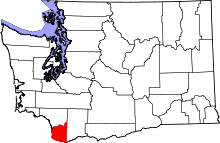Ridgefield, Washington
| Ridgefield, Washington | |
|---|---|
| Town | |
|
Downtown Ridgefield | |
 Location of Ridgefield, Washington | |
| Coordinates: 45°48′55″N 122°43′40″W / 45.81528°N 122.72778°WCoordinates: 45°48′55″N 122°43′40″W / 45.81528°N 122.72778°W | |
| Country | United States |
| State | Washington |
| County | Clark |
| Area[1] | |
| • Total | 7.18 sq mi (18.60 km2) |
| • Land | 7.08 sq mi (18.34 km2) |
| • Water | 0.10 sq mi (0.26 km2) |
| Elevation | 112 ft (34 m) |
| Population (2010)[2] | |
| • Total | 4,763 |
| • Estimate (2015)[3] | 6,455 |
| • Density | 672.7/sq mi (259.7/km2) |
| Time zone | Pacific (PST) (UTC-8) |
| • Summer (DST) | PDT (UTC-7) |
| ZIP code | 98642 |
| Area code | 360 |
| FIPS code | 53-58410 |
| GNIS feature ID | 1512604[4] |
| Website | www.ci.ridgefield.wa.us |
Ridgefield is a city in the pastoral, rolling-hills countryside of northern Clark County, Washington, United States. The population was 4,763 at the 2010 census.[5]
Ridgefield is notable for the significant Native American and Lewis and Clark Expedition history of the area, but is also the home of the Ridgefield National Wildlife Refuge, a primary reserve for migrating waterfowl on the Pacific Flyway, and the Ridgefield High School "Spudders" (reflecting the area's potato-farming heritage). The city is home to several annual community events, such as their old-fashioned Fourth of July Celebration, and also holds a bird festival that attracts bird lovers from around the region and beyond.
While the town of Ridgefield is in itself relatively modest in size, the geographic area that is locally also called Ridgefield is quite a bit larger, extending from the Columbia River to its immediate west, the Lewis River to the north, several miles past Interstate 5 to the east, and south nearly to Vancouver, Washington, encompassing both the Clark County Fairgrounds and the Amphitheater at Clark County .
History
The area has important ties to the Lewis and Clark Expedition of 1804–1806.
The town was formerly known as Union Ridge and was renamed Ridgefield in the late 1800s. [6]
Ridgefield was an important trading center as early as the 1860s, and the city was officially incorporated on August 26, 1909. U-Haul, an American equipment rental company, had its start in Ridgefield in 1945. The community's ties to the Chinookan people was commemorated by the construction of a replica of a Cathlapotle plankhouse at the Ridgefield National Wildlife Refuge, which was dedicated March 29, 2005.
Geography
Ridgefield is located at 45°48′55″N 122°43′40″W / 45.81528°N 122.72778°W (45.815309, -122.727846).[7]
According to the United States Census Bureau, the city has a total area of 7.18 square miles (18.60 km2), of which, 7.08 square miles (18.34 km2) is land and 0.10 square miles (0.26 km2) is water.[1]
In the physical lay of the land, (old, pre-Growth Management Act) Ridgefield is like many towns up and down the Columbia River in that it essentially dead-ends at the river, although in this case it is an offshoot of the Columbia River, Lake River, that the city runs up to, about three miles (5 km) west of Interstate 5.
The area is marked with numerous fields bordered by canyons, with ridges along them overlooking the canyons in places. The canyons are formed primarily by water erosion. The land has been cleared of much of its original forests to accommodate various uses as fields for farming, historcally potatoes and plums for prunes, and more recently residential development.
Demographics
| Historical population | |||
|---|---|---|---|
| Census | Pop. | %± | |
| 1910 | 297 | — | |
| 1920 | 620 | 108.8% | |
| 1930 | 607 | −2.1% | |
| 1940 | 643 | 5.9% | |
| 1950 | 762 | 18.5% | |
| 1960 | 823 | 8.0% | |
| 1970 | 1,004 | 22.0% | |
| 1980 | 1,062 | 5.8% | |
| 1990 | 1,297 | 22.1% | |
| 2000 | 2,147 | 65.5% | |
| 2010 | 4,763 | 121.8% | |
| Est. 2015 | 6,455 | [8] | 35.5% |
| U.S. Decennial Census[9] 2015 Estimate[3] | |||
2010 census
As of the census[2] of 2010, there were 4,763 people, 1,591 households, and 1,258 families residing in the city. The population density was 672.7 inhabitants per square mile (259.7/km2). There were 1,695 housing units at an average density of 239.4 per square mile (92.4/km2). The racial makeup of the city was 92.4% White, 0.9% African American, 0.8% Native American, 2.0% Asian, 0.1% Pacific Islander, 0.9% from other races, and 2.8% from two or more races. Hispanic or Latino of any race were 5.1% of the population.
There were 1,591 households of which 48.1% had children under the age of 18 living with them, 62.0% were married couples living together, 11.6% had a female householder with no husband present, 5.5% had a male householder with no wife present, and 20.9% were non-families. 16.2% of all households were made up of individuals and 6.1% had someone living alone who was 65 years of age or older. The average household size was 2.99 and the average family size was 3.34.
The median age in the city was 32.4 years. 33.5% of residents were under the age of 18; 6.2% were between the ages of 18 and 24; 29.7% were from 25 to 44; 22.9% were from 45 to 64; and 7.7% were 65 years of age or older. The gender makeup of the city was 49.9% male and 50.1% female.
2000 census
As of the census of 2000, there were 2,147 people, 739 households, and 557 families residing in the city. The population density was 420.8 people per square mile (162.5/km²). There were 777 housing units at an average density of 152.3 per square mile (58.8/km²). The racial makeup of the city was 95.16% White, 0.28% African American, 1.12% Native American, 0.70% Asian, 0.05% Pacific Islander, 0.23% from other races, and 2.47% from two or more races. Hispanic or Latino of any race were 1.77% of the population. 20.4% were of German, 18.9% American, 11.9% English, 6.9% Irish and 6.2% Norwegian ancestry.
There were 739 households out of which 43.8% had children under the age of 18 living with them, 58.6% were married couples living together, 11.8% had a female householder with no husband present, and 24.6% were non-families. 18.8% of all households were made up of individuals and 8.0% had someone living alone who was 65 years of age or older. The average household size was 2.82 and the average family size was 3.18.
In the city the age distribution of the population shows 29.8% under the age of 18, 7.6% from 18 to 24, 29.6% from 25 to 44, 22.4% from 45 to 64, and 10.7% who were 65 years of age or older. The median age was 36 years. For every 100 females there were 98.1 males. For every 100 females age 18 and over, there were 94.8 males.
The median income for a household in the city was $46,012, and the median income for a family was $51,121. Males had a median income of $38,125 versus $27,426 for females. The per capita income for the city was $21,696. About 4.4% of families and 6.3% of the population were below the poverty line, including 6.6% of those under age 18 and 9.0% of those age 65 or over.
Education
The Ridgefield school district has four schools: Union Ridge Elementary, South Ridge Elementary, View Ridge Middle School, and Ridgefield High School.
Notable people
- Scott Mosier, film producer and podcaster
- Richie Sexson, former major league baseball player
References
- 1 2 "US Gazetteer files 2010". United States Census Bureau. Retrieved 2012-12-19.
- 1 2 "American FactFinder". United States Census Bureau. Retrieved 2012-12-19.
- 1 2 "Population Estimates". United States Census Bureau. Retrieved July 1, 2016.
- ↑ "US Board on Geographic Names". United States Geological Survey. 2007-10-25. Retrieved 2008-01-31.
- ↑ "2010 Census Redistricting Data (Public Law 94-171) Summary File". American FactFinder. United States Census Bureau. Archived from the original on July 21, 2011. Retrieved 16 September 2012.
- ↑ Wilhelm, Honor L. (1 January 1908). "The Coast". Coast Publishing Company. Retrieved 5 July 2016 – via Google Books.
- ↑ "US Gazetteer files: 2010, 2000, and 1990". United States Census Bureau. 2011-02-12. Retrieved 2011-04-23.
- ↑ "Annual Estimates of the Resident Population for Incorporated Places: April 1, 2010 to July 1, 2015". Retrieved July 2, 2016.
- ↑ United States Census Bureau. "Census of Population and Housing". Archived from the original on May 11, 2015. Retrieved September 19, 2013.

